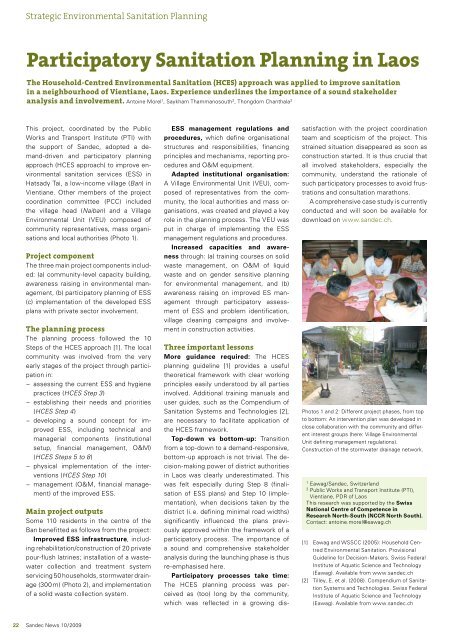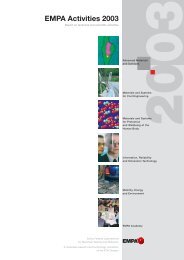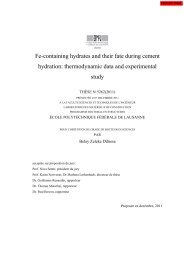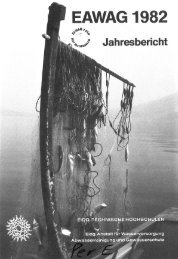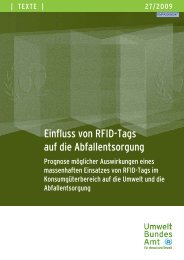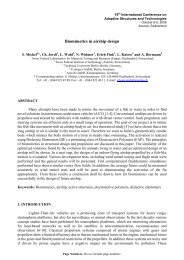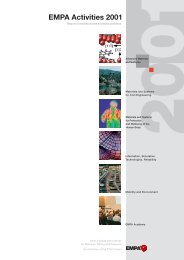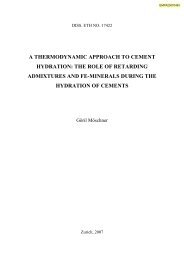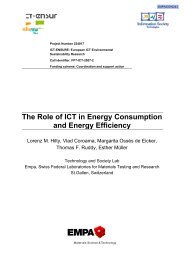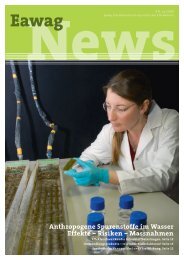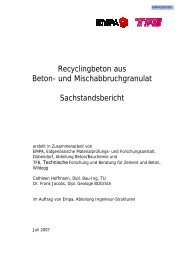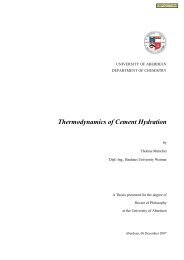Sandec - Eawag
Sandec - Eawag
Sandec - Eawag
You also want an ePaper? Increase the reach of your titles
YUMPU automatically turns print PDFs into web optimized ePapers that Google loves.
Strategic Environmental Sanitation Planning<br />
Participatory Sanitation Planning in Laos<br />
The Household-Centred Environmental Sanitation (HCES) approach was applied to improve sanitation<br />
in a neighbourhood of Vientiane, Laos. Experience underlines the importance of a sound stakeholder<br />
analysis and involvement. Antoine Morel 1 , Saykham Thammanosouth 2 , Thongdom Chanthala 2<br />
This project, coordinated by the Public<br />
Works and Transport Institute (PTI) with<br />
the support of <strong>Sandec</strong>, adopted a demand-driven<br />
and participatory planning<br />
approach (HCES approach) to improve environmental<br />
sanitation services (ESS) in<br />
Hatsady Tai, a low-income village (Ban) in<br />
Vientiane. Other members of the project<br />
coordination committee (PCC) included<br />
the village head (Naiban) and a Village<br />
Environmental Unit (VEU) composed of<br />
community representatives, mass organisations<br />
and local authorities (Photo 1).<br />
Project component<br />
The three main project components included:<br />
(a) community-level capacity building,<br />
awareness raising in environmental management,<br />
(b) participatory planning of ESS<br />
(c) implementation of the developed ESS<br />
plans with private sector involvement.<br />
The planning process<br />
The planning process followed the 10<br />
Steps of the HCES approach [1]. The local<br />
community was involved from the very<br />
early stages of the project through participation<br />
in:<br />
− assessing the current ESS and hygiene<br />
practices (HCES Step 3)<br />
− establishing their needs and priorities<br />
(HCES Step 4)<br />
− developing a sound concept for improved<br />
ESS, including technical and<br />
managerial components (institutional<br />
setup, financial management, O&M)<br />
(HCES Steps 5 to 8)<br />
− physical implementation of the interventions<br />
(HCES Step 10)<br />
− management (O&M, financial management)<br />
of the improved ESS.<br />
Main project outputs<br />
Some 110 residents in the centre of the<br />
Ban benefitted as follows from the project:<br />
Improved ESS infrastructure, including<br />
rehabilitation/construction of 20 private<br />
pour-flush latrines; installation of a wastewater<br />
collection and treatment system<br />
servicing 50 households, stormwater drainage<br />
(300 m) (Photo 2), and implementation<br />
of a solid waste collection system.<br />
<strong>Sandec</strong> News 10/2009<br />
ESS management regulations and<br />
procedures, which define organisational<br />
structures and responsibilities, financing<br />
principles and mechanisms, reporting procedures<br />
and O&M equipment.<br />
Adapted institutional organisation:<br />
A Village Environmental Unit (VEU), composed<br />
of representatives from the community,<br />
the local authorities and mass organisations,<br />
was created and played a key<br />
role in the planning process. The VEU was<br />
put in charge of implementing the ESS<br />
management regulations and procedures.<br />
Increased capacities and awareness<br />
through: (a) training courses on solid<br />
waste management, on O&M of liquid<br />
waste and on gender sensitive planning<br />
for environmental management, and (b)<br />
awareness raising on improved ES management<br />
through participatory assessment<br />
of ESS and problem identification,<br />
village cleaning campaigns and involvement<br />
in construction activities.<br />
Three important lessons<br />
More guidance required: The HCES<br />
planning guideline [1] provides a useful<br />
theoretical framework with clear working<br />
principles easily understood by all parties<br />
involved. Additional training manuals and<br />
user guides, such as the Compendium of<br />
Sanitation Systems and Technologies [2],<br />
are necessary to facilitate application of<br />
the HCES framework.<br />
Top-down vs bottom-up: Transition<br />
from a top-down to a demand-responsive,<br />
bottom-up approach is not trivial. The decision-making<br />
power of district authorities<br />
in Laos was clearly underestimated. This<br />
was felt especially during Step 8 (finalisation<br />
of ESS plans) and Step 10 (implementation),<br />
when decisions taken by the<br />
district (i. e. defining minimal road widths)<br />
significantly influenced the plans previously<br />
approved within the framework of a<br />
participatory process. The importance of<br />
a sound and comprehensive stakeholder<br />
analysis during the launching phase is thus<br />
re-emphasised here.<br />
Participatory processes take time:<br />
The HCES planning process was perceived<br />
as (too) long by the community,<br />
which was reflected in a growing dis-<br />
satisfaction with the project coordination<br />
team and scepticism of the project. This<br />
strained situation disappeared as soon as<br />
construction started. It is thus crucial that<br />
all involved stakeholders, especially the<br />
community, understand the rationale of<br />
such participatory processes to avoid frustrations<br />
and consultation marathons.<br />
A comprehensive case study is currently<br />
conducted and will soon be available for<br />
download on www.sandec.ch.<br />
Photos 1 and 2: Different project phases, from top<br />
to bottom: An intervention plan was developed in<br />
close collaboration with the community and different<br />
interest groups (here: Village Environmental<br />
Unit defining management regulations).<br />
Construction of the stormwater drainage network.<br />
1 <strong>Eawag</strong>/<strong>Sandec</strong>, Switzerland<br />
2 Public Works and Transport Institute (PTI),<br />
Vientiane, PDR of Laos<br />
This research was supported by the Swiss<br />
National Centre of Competence in<br />
Research North-South (NCCR North South).<br />
Contact: antoine.morel@eawag.ch<br />
[1] <strong>Eawag</strong> and WSSCC (2005): Household Centred<br />
Environmental Sanitation. Provisional<br />
Guideline for Decision-Makers. Swiss Federal<br />
Institute of Aquatic Science and Technology<br />
(<strong>Eawag</strong>). Available from www.sandec.ch<br />
[2] Tilley, E. et al. (2008). Compendium of Sanitation<br />
Systems and Technologies. Swiss Federal<br />
Institute of Aquatic Science and Technology<br />
(<strong>Eawag</strong>). Available from www.sandec.ch


